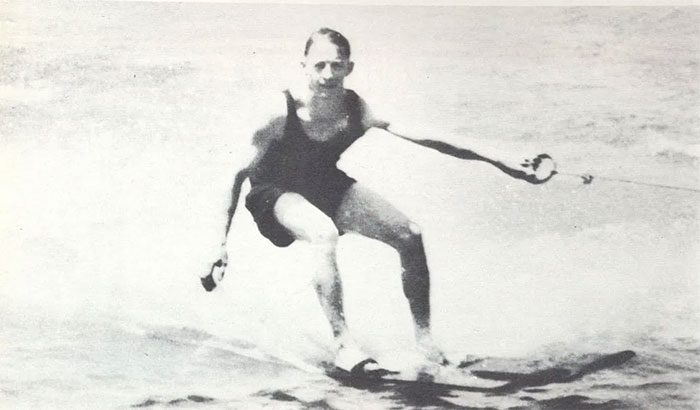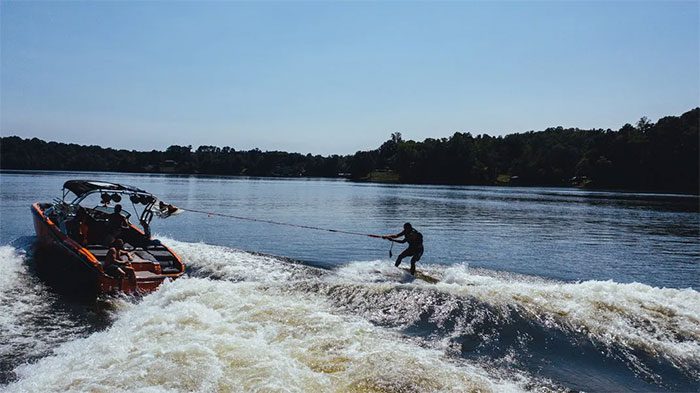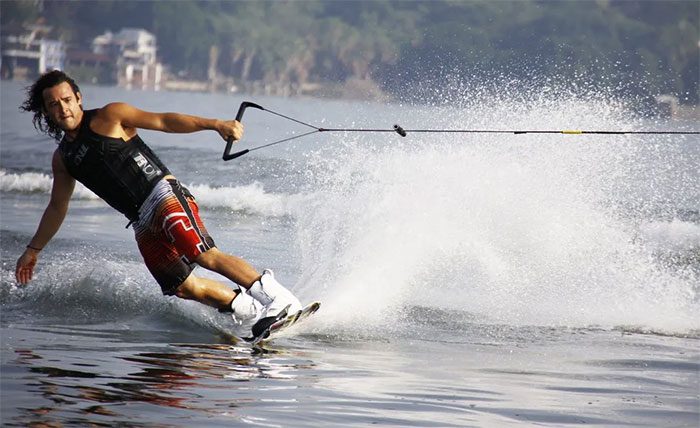In the summer of 1922, 18-year-old Ralph Samuelson made a bold decision for his time: to try standing on a water ski on Lake Pepin, just a few blocks from his home. After many attempts and failures, Samuelson finally succeeded, giving birth to one of the world’s most beloved water sports.

Ralph Samuelson on water skis.
This summer marks the 100th anniversary of the birth of water skiing. To express gratitude for Samuelson’s contributions to summer recreation, the residents of Lake City, Minnesota – Samuelson’s hometown – are organizing a unique event. At 4:11 PM on July 2, coinciding with the moment Samuelson first stood upright on the water with his brother’s boat 100 years ago, the city will unveil a life-sized bronze statue of Samuelson.
The new statue will be placed at Ohuta Park and Beach on the shore of Lake Pepin. City officials have allocated $75,000 for the statue, which has been cast by a team of skilled local artisans.
John Hutchinson, president of Destination Lake City, stated: “This will be a historic moment for the city. We want people to stop and take selfies with Ralphie’s statue.”
In the near future, city leaders hope to establish a renowned water ski hall of fame. In the meantime, tourists can enjoy Water Ski Day, an annual celebration in Lake City featuring water ski performances, lively music, and many other exciting activities. This month, local filmmaker Ben Threinen will release a new 33-minute documentary about Samuelson’s invention. Additionally, “Bears on Boards: Waterskiing in White Bear,” an exhibition celebrating the 100th anniversary of water skiing, has also been launched by historians in Minnesota.

Modern water skiers still stand up in the same way Samuelson did 100 years ago.
The journey of inventing water skiing was not easy. According to historians, during his first attempt, Samuelson used a device called an aquaplane – a large, flat board that was towed behind his brother’s boat. On June 28, 1922, he managed to glide a short distance on the water using the aquaplane, but he believed he could do much better.
Samuelson continued to attempt skiing on a snowboard and thin wooden planks, but none were successful. Eventually, he realized he needed something that could cover more surface area on the water. He went to a local lumberyard and found two pine boards, each 8 feet long and 9 inches wide. He softened one end of each board and then bent them by clamping the ends with glass. He used leather straps to secure the boards to his feet and purchased an additional 100 feet of rope for towing. Finally, he hired a blacksmith to make a small iron ring for the handle of the rope.
In the days that followed, Samuelson experimented with numerous skiing postures, primarily keeping the skis level with or below the waterline. When his brother started the boat, Samuelson would immediately sink.
Eventually, Samuelson tried lifting the tips of the skis above the water while leaning back. The result did not disappoint him; as the boat accelerated, Samuelson was able to stand upright and glide effortlessly on the water in sheer joy. To this day, that remains the posture that water skiers must adhere to.
Not stopping there, Samuelson continued to learn how to perform on his skis, drawing large crowds to watch. He began charging for admission to the shows and donated the proceeds to the town to cover the fuel costs of the boat. The town also formed a small band by the lake to accompany Samuelson’s performances.

Today, water skiing and wakeboarding are popular summer pastimes.
Sadly, his water skiing career did not last long. After suffering a back injury in a construction accident in 1927, Samuelson was forced to stop performing to focus on his health, never receiving any accolades for his inventions. Later, a few athletes in New York and France even attempted to claim they were the first to ski on water. In 1925, American inventor Fred Waller was awarded a patent for the first water ski.
However, many people had seen Samuelson water skiing long before that, and he eventually received recognition as the inventor of the sport.
Today, water skiing has evolved into a popular summer sport for both professional and amateur players. It was included in the Olympics as a demonstration sport in 1972, and by 1974, the first National Water Ski Championships were held in the U.S. Water skiing has also been incorporated into college curricula, and by 1979, teams from schools began competing for national titles.
Although he passed away from cancer in 1977, Samuelson’s legacy endures. Today, visitors can see his first water skis at the Hall of Fame of the Water Ski & Wake Sports Organization in Davenport, Florida. There is also another historical landmark, Lake Pepin, regarded as “The Birthplace of Water Skiing.”




















































